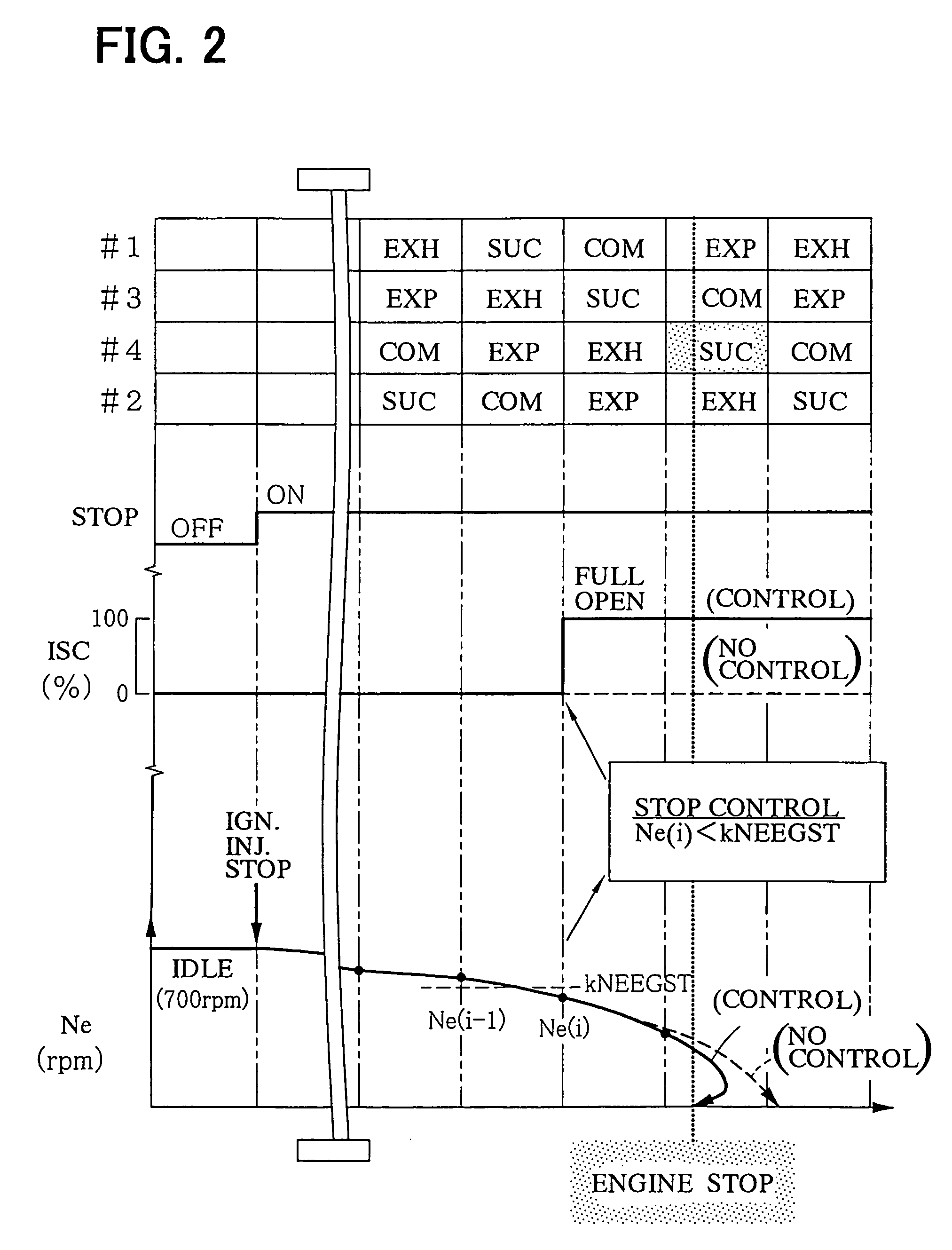Apparatus for controlling engine rotation stop by estimating kinetic energy and stop position
a technology of kinetic energy and engine, which is applied in the direction of electrical control, lighting and heating apparatus, instruments, etc., can solve the problems of difficult to improve a starting operation and exhaust emission at the start, the crank angle at the time of engine rotation stop cannot be exactly detected, and the accuracy of estimation is difficult to achieve. , to achieve the effect of improving the starting quality and exhaust emission, and reducing the variation of the engine rotation stop position
- Summary
- Abstract
- Description
- Claims
- Application Information
AI Technical Summary
Benefits of technology
Problems solved by technology
Method used
Image
Examples
first embodiment
(First Embodiment)
[0049]Referring first to FIG. 1, a throttle valve 14 is provided midway in an intake pipe 13 connected to intake ports 12 of an engine 11, and an opening degree (throttle opening degree) TA of the throttle valve 14 is detected by a throttle opening degree sensor 15. Provided in the intake pipe 13 is a bypass passage 16 to bypass the throttle valve 14, and provided midway the bypass passage 16 is an idling speed control valve (ISC valve) 17. Provided on the downstream side of the throttle valve 14 is an intake pipe pressure sensor 18 for detecting an intake pipe pressure PM, and mounted in the vicinity of the intake ports 12 of respective cylinders are fuel injection valves 19.
[0050]A catalyst 22 for purification of exhaust gases is installed midway in an exhaust pipe 21 connected to exhaust ports 20 of the engine 11. Provided on a cylinder block of the engine 11 is a cooling water temperature sensor 23 for detecting a cooling water temperature THW. A crank angle se...
second embodiment
(Second Embodiment)
[0107]A second embodiment of the present invention is also configured, as shown in FIG. 11, in the same manner as the first embodiment (FIG. 1).
[0108]According to the second embodiment, an engine rotation stop position is estimated as indicated in a time chart in the course of engine stop shown in FIG. 14. An instantaneous engine rotational speed Ne at respective compression TDCs is used as a parameter representative of engine operation. The ECU 30 measures a period of time required for rotation of the crankshaft 24 over, for example, 30° CA on the basis of output intervals of crank pulse signals CRS to calculate the instantaneous rotational speed Ne.
[0109]Here, energy balance at an i-th compression TDC (TDC(i)) in FIG. 14 is considered. Pumping loss, friction loss in respective parts, and driving loss in respective auxiliary devices are taken into account as work to obstruct engine operations. Assuming kinetic energy of an engine at a point of time TDC(i−1) to be...
third embodiment
(Third Embodiment)
[0131]In the second embodiment, whether engine rotation is stopped is determined depending upon a predicted value of an instantaneous rotational speed at TDC being the first in the future, so that an engine rotation stop position is estimated just before engine rotation is stopped.
[0132]Hereupon, according to the third embodiment, the processing of estimating a further future instantaneous rotational speed is repeated by the use of a predicted value of a future instantaneous rotational speed and a parameter for obstructing motions, until it is determined that engine rotation is stopped, so that an engine rotation stop position can be estimated even not just before engine rotation is stopped.
[0133]A method of estimating an engine rotation stop position, according to the third embodiment is described below with reference to a time chart shown in FIG. 17. A parameter Cstop for obstructing engine operations, and a predicted value of an instantaneous rotational speed Ne...
PUM
 Login to View More
Login to View More Abstract
Description
Claims
Application Information
 Login to View More
Login to View More - R&D
- Intellectual Property
- Life Sciences
- Materials
- Tech Scout
- Unparalleled Data Quality
- Higher Quality Content
- 60% Fewer Hallucinations
Browse by: Latest US Patents, China's latest patents, Technical Efficacy Thesaurus, Application Domain, Technology Topic, Popular Technical Reports.
© 2025 PatSnap. All rights reserved.Legal|Privacy policy|Modern Slavery Act Transparency Statement|Sitemap|About US| Contact US: help@patsnap.com



